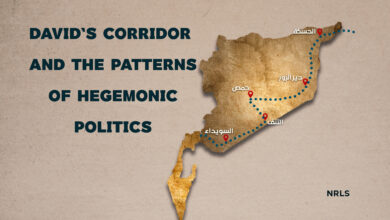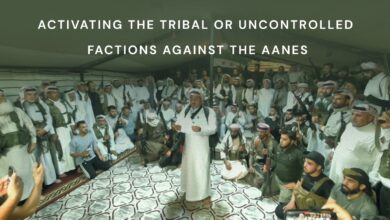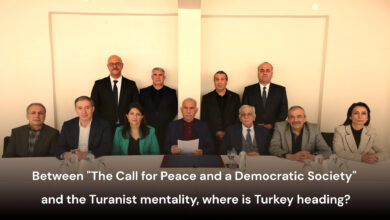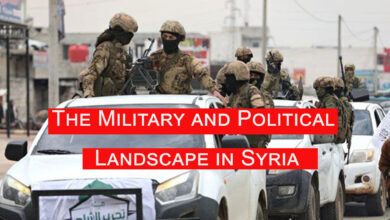The Future of Syria Under the New Regime

The Assad regime ended at the hands of Hayat Tahrir al-Sham (HTS), led by its leader Abu Muhammad al-Julani, after a rule that lasted for more than half a century of dictatorship, suppression of freedoms, marginalization of the components of the Syrian people, and crimes and arrests during those years, especially during the Syrian crisis. This is despite the questions about whether the organization was capable of eliminating the regime, or whether its military progress was made under American protection after preparing the military and even political conditions for this stage to end the Assad regime and allow HTS to control Damascus. Subsequently, Ahmed al-Sharaa (formerly known as Abu Muhammad al-Julani) assumed the position of interim Syrian president after obtaining the approval of the leaders of HTS and the military factions under its banner.
Does the interim Syrian president have the ability to steer the country towards a democratic, pluralistic Syria, or will he lead it towards a new crisis based on radical jihadist organizations, spreading their ideology, and committing more crimes? What is the policy of the United States and Israel towards Syria during this stage?
The pressures exerted by regional and international countries “Turkey, Israel, Arab countries, the United States, and the European Union” on Ahmed al-Sharaa cannot be ignored. In addition to the fact that HTS is still classified on terrorism lists and the continuation of sanctions on Syria, all of this poses challenges for al-Sharaa and his government, and constitutes an obstacle to building a modern Syria. However, this does not mean justifying the position and finding excuses. The policy pursued by al-Sharaa has not been up to the aspirations of the Syrian people for a democratic Syria, but rather leads the country towards a dark tunnel.
Policy of One Color
Since his arrival at the Presidential Palace, al-Sharaa’s statements have not matched his actions, as if his statements were directed to the outside and not to the inside in order to whitewash his image. The policy pursued by Ahmed al-Sharaa is no less than the policy pursued by the ousted regime in some respects, especially those related to controlling the government by forming a committee of one color “from his entourage” to prepare for the Syrian National Conference, and the meetings held by this committee with figures who are mostly supportive of it. Parties, blocs, forces, and national figures representing the Syrian components and believing in a democratic pluralistic system have been neutralized, which made the fate of this conference a failure even before it convened as a result of the great criticism directed at it by the free Syrian people. As for the new Syrian army, despite al-Sharaa’s statements to dissolve all armed factions and join the new Syrian army, these statements did not receive any response from Turkey’s mercenaries in occupied northern Syria. Even those factions that announced their dissolution and joining the new Syrian army, no change occurred in them. Those factions remained as one bloc linked to their leaders, implementing their orders, and working to implement the external agenda. As for the constitution that was drafted by a committee similar to the preparatory committee for the Syrian conference, that committee drafted the constitution to fit the organization or the new regime, and granted the interim president an immunity that only kings possessed in the Middle Ages. The majority of the Syrian people rejected this constitution.
How can such a conference determine the future of the new Syria? How can this army protect Syria, land, and people? Rather, this army is no less than the regime’s army, which believed that its mission was to protect the Syrian people, but in reality, it was to protect the regime and commit massacres against everyone who opposed it. We find the same thing among the factions under the banner of the new Syrian army. How can a constitution that is considered a copy of the Ba’ath constitution transfer Syria to a democratic pluralistic system?
Therefore, what is happening in Syria does not bode well as long as this radical mentality remains that turns a blind eye to the social, cultural, ethnic, and religious diversity that characterizes the Syrian people.
Foreign Interventions in Syria
After the fall of the Assad regime, countries swarmed over Syria, all trying to get the lion’s share of the Syrian pie, especially the Turkish state, which has strong relations with HTS (currently the Syrian regime). Therefore, Turkey is trying to extend its influence to encompass all aspects of the state and is establishing new military bases in western Syria and deep inside Syria in ” Palmyra.” This has led to the emergence of an indirect conflict with Israel, which is also trying to control the political decision-making in Damascus and remain in the occupied southern Syria. Israel does not allow the new Syrian army to enter southern Syria and claims to support the protection of the Druze component in Suweyda. Therefore, the authority of the new regime will be weak, even non-existent, in southern Syria. As for the United States, it aims – indirectly – to change the form of government in Syria to a decentralized or federal system, which is one of the main demands of the Autonomous Administration and the Kurdish people, who have suffered greatly at the hands of the central regime, which has shown its failure to achieve justice, freedom, and equality in Syria.
The policy pursued by Ahmed al-Sharaa and his entourage is linked to a foreign agenda. Al-Sharaa and his military factions do not have the ability to end their dependence on those countries, especially the Turkish occupation state, as if their existence is linked to those countries. This is the same logic that the defunct regime followed by linking itself to Iran and its Shiite axis and moving away from the Arab axis, which led to its political and economic weakness and caused a crisis that plagued the country for fourteen years, resulting in the fall of the regime and the flight of the head of the regime to Russia.
It cannot be denied that this new regime is under great external pressure, but it must draw its strength from its Arab surroundings and from the Syrian people, not from Turkey. It must also take into account the ethnic, religious, and cultural diversity that distinguishes the Syrian people and learn lessons from the defunct regime and its fate.
Al-Sharaa and his regime, through this policy they are pursuing, are not leading Syria to safety. All the steps taken by Ahmed al-Sharaa since assuming power have not met the aspirations of the Syrian people, who have suffered from the tyranny and crimes of the defunct regime and its displacement of millions of Syrian people abroad. Rather, his policy is considered an extension of the policy of the defunct regime itself.
United States Policy Towards the New Regime
The United States of America’s keeping of Ahmed al-Sharaa and HTS on the lists of terrorism may be for purposes related to the American policy towards Syria. Keeping them on the lists of terrorism means that they are vulnerable to targeting by the United States or Israel, which means that any move or policy that does not serve the United States, or, if one may say so, any departure from the path that has been drawn for the new regime will be met with a response from the United States or Israel.
Therefore, this regime is proceeding directly or indirectly according to a specific plan drawn for it. Despite the massacres committed by the new Syrian army, specifically the Turkish mercenaries “Al-Hamzat and Al-Amshat” and some other factions, against the Alawi component, there is no international condemnation of the new regime, as if the United States has turned a blind eye to the practices of the new regime and allowed it to commit more massacres and follow a policy of one color, all to reach its desired goals in Syria without exerting any pressure, whether on local forces “inside Syria” or on regional countries, to accept the form of the new regime for Syria. This means that if there are red lines at the present time regarding the form of the regime in Syria, then those red lines will become green lines with the approval of all parties and regional forces opposed to changing the form of the old regime.
Therefore, the final picture of the future of Syria remains vague and unpredictable as long as there are foreign interventions and as long as the policy of one color continues. However, what is clear now is the fall of the defunct regime and the inability of its remnants to change the Syrian situation. Also, the project of the Autonomous Administration “Democratic Nation” and the Syrian Democratic Forces are the glimmer that shines in the dark sky towards a decentralized, democratic, pluralistic Syria in which the rights of all components, ethnicities, and religions are protected.




